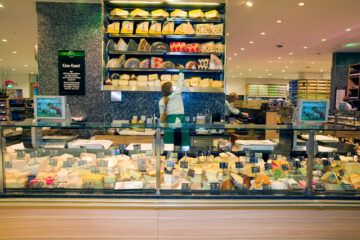The zbb conducted the pilot test at the School of Business and Tourism Berlin (SFT Schule für Wirtschaft und Tourismus Berlin GmbH) and demonstrated a way to further modernise initial vocational training.
Six apprentices of the vocational school class Skil15 in the profession “service agent in air transport” were involved in the pilot test and successfully mastered their design challenge “inspire more customers to use self-check-in terminals”. The apprentices went through all five phases of the Design Thinking model. They identified and determined the problem of the Design Challenge through their own research, conducted interviews and observed their target group at the airport. They were able to identify the needs and put themselves in the customers’ mindset. They came up with creative and innovative solution ideas for the identified problem “Lack of visibility of self-check-in terminals and built a prototype. In this way, they illustrated the idea and made it tangible. In the end, they presented their prototype to the expert group and tested it. The feedback from the expert group was processed by the apprentices and flowed into the further development of the solution idea. In only two months, the training model developed in the project according to Design Thinking and the guideline for trainers could be successfully tested. The aim of the teaching project was to carry out a project with the apprentices using the Design Thinking method and to expand their problem-solving skills and competences. The learners were supported and guided by the trainer in all phases. In the form of lectures and worksheets, the trainer provided the teaching material on the five phases of the Design Thinking method. A ready-made list of links introduced the apprentices to the Design Challenge topic. Prepared question and observation sheets were used by the apprentices for the empirical study at the airport. Especially the analysis and evaluation of the interviews and observations in phase 2 “Define” was a big challenge for the apprentices. In this project phase, they needed good methodological skills and thus the most support from the trainer. The phase “Ideate” was also supported by the trainer by suggesting a creative method (brainstorming) to find ideas and setting rules of conduct. This phase was a lot of fun for the apprentices. They came up with many ideas and were able to implement the recommendations of the trainer. The idea to mark the self-check-in counter with colours and thus increase their visibility to customers was accepted. The apprentices had to think with their hands and build a prototype of their idea. This step was also easy for the apprentices and they drew a sketch of the airport counter, which was marked in colour. They designed a boarding pass and used the airport map to illustrate the colour markings. In the last step, the trainer talked through the presentation process with the group. The apprentices presented their solution idea to the group of experts and discussed the practicability. The recommendations were adopted in the concept. Apprentices have learned to interpret a customer’s needs so that a basic specification can be produced; they have learned to build a prototype that grasps the essence of the design idea, and to develop the design further through testing. They have learned to listen carefully to the target group, and to judge which technical vocabulary to use and which to translate into layman’s terms. They have followed published guidelines so that the target audience can understand and comprehend their solution ideas. They have presented and documented their solution idea well. They always try to learn more about the Design Challenge and deepen their knowledge, such as conducting interviews and observations and using additional resources (article research) or consulting with experts. The apprentices have learnt to grasp and implement several new methodological concepts, to process and analyse data effectively. They developed their social skills by treating other group members with respect, valuing their opinions and contributions and supporting each other. The apprentices got to know their future working environment and felt comfortable in it. They gained experience of which characteristics and functions are related to working at the airport. Furthermore, they appreciated the way an expert (service employee) dealt with the target group, in terms of know how and service performance.


